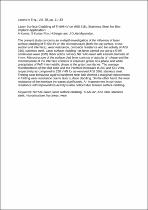 ResearchSpace
ResearchSpace
Laser surface cladding of Ti-6Al-4V on AISI 316L stainless steel for bio-implant application
JavaScript is disabled for your browser. Some features of this site may not work without it.
- ResearchSpace
- →
- Research Publications/Outputs
- →
- Journal Articles
- →
- View Item
| dc.contributor.author |
Kumar, A

|
|
| dc.contributor.author |
Roy, SK

|
|
| dc.contributor.author |
Burger, H

|
|
| dc.contributor.author |
Majumdar, JD

|
|
| dc.date.accessioned | 2015-11-04T11:57:58Z | |
| dc.date.available | 2015-11-04T11:57:58Z | |
| dc.date.issued | 2014 | |
| dc.identifier.citation | Kumar, A, Roy, SK, Burger, H, Majumdar, JD. 2014. Laser surface cladding of Ti-6Al-4V on AISI 316L stainless steel for bio-implant application. Lasers in Engineering, vol.28(1-2), pp 11-33. | en_US |
| dc.identifier.issn | 0898-1507 | |
| dc.identifier.uri | http://hdl.handle.net/10204/8235 | |
| dc.description | Copyright: 2014 Old City Publishing. This is the abstract only. The fulltext and definitive version is published in Lasers in Engineering, Vol. 28(1-2), pp 11-33. | en_US |
| dc.description.abstract | The present study concerns an in-depth investigation of the influence of laser surface cladding of Ti-6Al-4V on the microstructure (both the top surface, cross-section and interface), wear resistance, corrosion resistance and bio-activity of AISI 316L stainless steel. Laser surface cladding has been carried out using a 5 kW continuous wave (CW) fibber optics delivery Nd: YAG laser with a beam diameter of 4 mm. Microstructure of the surface clad layer consists of acicular a’ -phase and the microstructure of the interface consists of equiaxed grains of a-phase and white precipitates of FeTi intermetallic phase at the grain boundaries. The average microhardness of the clad zone and the interface increases to 240 and 531 VHN, respectively as compared to 220 VHN for as-received AISI 316L stainless steel. Fretting wear behaviour against hardened steel ball showed a marginal improvement in fretting wear resistance due to laser surface cladding. On the other hand, the wear resistance of the interface increases significantly. An improvement in corrosion resistance with improved bio-activity is also noticed due to laser surface cladding. | en_US |
| dc.language.iso | en | en_US |
| dc.relation.ispartofseries | Worklist;14327 | |
| dc.subject | Nd:YAG laser | en_US |
| dc.subject | Laser surface cladding | en_US |
| dc.subject | Ti-6Al-4V | en_US |
| dc.subject | AISI 316L stainless steel | en_US |
| dc.subject | Microstructures | en_US |
| dc.title | Laser surface cladding of Ti-6Al-4V on AISI 316L stainless steel for bio-implant application | en_US |
| dc.type | Article | en_US |
| dc.identifier.apacitation | Kumar, A., Roy, S., Burger, H., & Majumdar, J. (2014). Laser surface cladding of Ti-6Al-4V on AISI 316L stainless steel for bio-implant application. http://hdl.handle.net/10204/8235 | en_ZA |
| dc.identifier.chicagocitation | Kumar, A, SK Roy, H Burger, and JD Majumdar "Laser surface cladding of Ti-6Al-4V on AISI 316L stainless steel for bio-implant application." (2014) http://hdl.handle.net/10204/8235 | en_ZA |
| dc.identifier.vancouvercitation | Kumar A, Roy S, Burger H, Majumdar J. Laser surface cladding of Ti-6Al-4V on AISI 316L stainless steel for bio-implant application. 2014; http://hdl.handle.net/10204/8235. | en_ZA |
| dc.identifier.ris | TY - Article AU - Kumar, A AU - Roy, SK AU - Burger, H AU - Majumdar, JD AB - The present study concerns an in-depth investigation of the influence of laser surface cladding of Ti-6Al-4V on the microstructure (both the top surface, cross-section and interface), wear resistance, corrosion resistance and bio-activity of AISI 316L stainless steel. Laser surface cladding has been carried out using a 5 kW continuous wave (CW) fibber optics delivery Nd: YAG laser with a beam diameter of 4 mm. Microstructure of the surface clad layer consists of acicular a’ -phase and the microstructure of the interface consists of equiaxed grains of a-phase and white precipitates of FeTi intermetallic phase at the grain boundaries. The average microhardness of the clad zone and the interface increases to 240 and 531 VHN, respectively as compared to 220 VHN for as-received AISI 316L stainless steel. Fretting wear behaviour against hardened steel ball showed a marginal improvement in fretting wear resistance due to laser surface cladding. On the other hand, the wear resistance of the interface increases significantly. An improvement in corrosion resistance with improved bio-activity is also noticed due to laser surface cladding. DA - 2014 DB - ResearchSpace DP - CSIR KW - Nd:YAG laser KW - Laser surface cladding KW - Ti-6Al-4V KW - AISI 316L stainless steel KW - Microstructures LK - https://researchspace.csir.co.za PY - 2014 SM - 0898-1507 T1 - Laser surface cladding of Ti-6Al-4V on AISI 316L stainless steel for bio-implant application TI - Laser surface cladding of Ti-6Al-4V on AISI 316L stainless steel for bio-implant application UR - http://hdl.handle.net/10204/8235 ER - | en_ZA |





